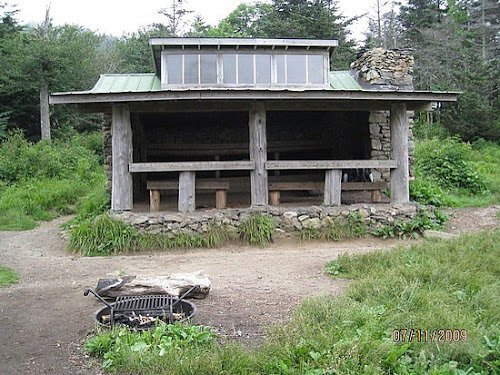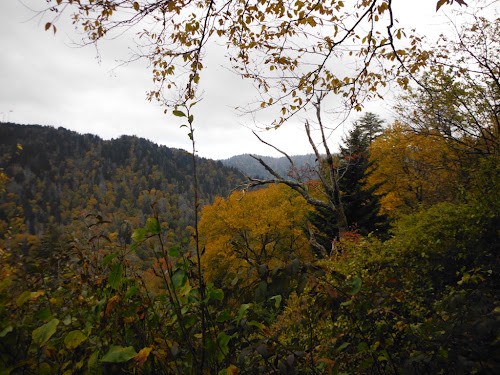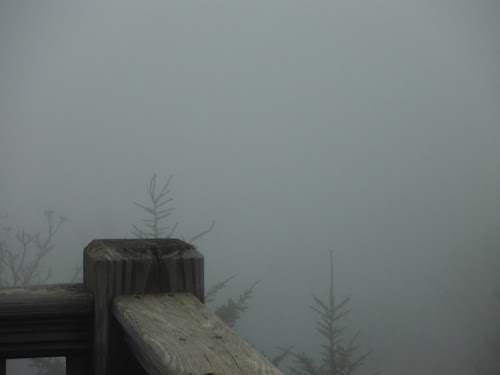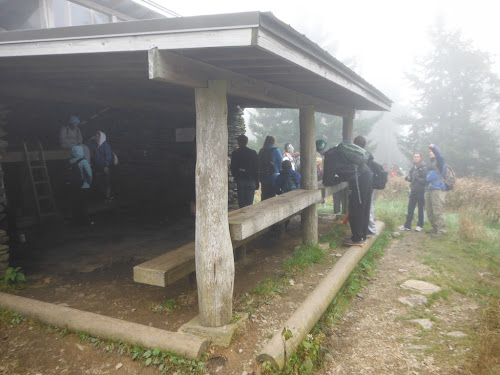 |
| Stunning Vistas from the Mt. Cammerer Lookout |
Breathtaking views awaited us on this clear, crisp November morning as we gathered in Knoxville and carpooled out to the Cosby Campground to make our last long hike of the fall season. Time had changed now, so Daylight Savings Time would no longer shift the clock in our favor; instead, we would see the sun setting at 5:31 p.m. The Lower Mt. Cammerer--Appalachian Trail--Low Gap Trail loop is a 15.7 mile venture that we had selected as our last hoorah hike of the fall because destination hikes like this are our little hiking group's favorite type of scramble through the woods. Two of the members of the Bucket Brigade, our group of ladies who spend at least two to three days a month working toward the 900 miles of trails in the Smokies, are close to a personal goal of 250 miles and 200 miles completed by the end of the year. Short days and colder temperatures threaten to impede these goals, but we were not to be deterred on this day.


We arrived at the Cosby Campground parking area about the time the sun was coming up--7:30 a.m. However, to our dismay, the bathrooms at the campground/picnic area were closed, there were no pit toilets available, and we had consumed a fair amount of coffee on the way. We determined that we must retreat in search of facilities! We had to drive back toward the interstate about 8 miles to find what we so desperately needed, but thankfully a little country store was open early on this Saturday morning. I could write a whole blog entry on this quaint little store with its old-fashioned cash register and its small group of tables at the back where, undoubtedly, the liars' club convenes for coffee every morning. I love those flashbacks into the past when I stumble on a place like this.
Having lost at least 30 minutes of precious daylight, we donned our gear and headed up Lower Mt. Cammerer trail, a nice easy grade trail which skirts the base of Mt. Cammerer, winding and climbing slowly toward an intersection with the Appalachian Trail somewhere near the ridge line. This enjoyable path ascended at a grade similar to that of a rails-to-trails bike path. There were times when you really didn't even notice that you were climbing, but you knew you must be. At this time of year, with most of the trees having dropped their leaves to the forest floor, there were ample opportunities for pleasant views of the surrounding mountains. Sutton Overlook, a detour of about a quarter mile, offered a tease of what lay ahead for us with a nice view and enough cell phone service to text a picture to family at home.
Lower Mt. Cammerer trail, however, did not go unscathed during Superstorm Sandy's visit to the Smokies a week and a half earlier. Numerous rhododendron bushes had broken or had bent and bowed under the weight of the heavy snow she dropped on this region. I cannot imagine how many of these beautiful shrubs on the whole face of Cammerer were damaged because we had to go under, over, or around at least 25 on this trail. In one spot, a large tree had uprooted and fallen over the trail leaving a gaping hole in the mountainside. We had no choice but to scramble up and over the root ball in the loose soil of that wound simply because there was no other way around it.
It was somewhere along the Lower Mt. Cammerer trail that we began to hear large rustling sounds in the woods around us. We had probably been hiking 4 or 5 miles and the rhododendron thickets were dense enough that we could hear the movements of some fairly large creature, but we could not see him. We promptly began talking loudly to each other and I took my safety whistle and blew it three quick bursts. The Bucket Brigade member who was leading the way, Andrea, jumped, screamed, turned around, and ran back to literally hide behind me and between me and Jennifer. I've honestly never seen a human being move that fast in person! We need to sign her up for the Olympics! That had to be a record time--too bad there's not a 10-yard dash event--she would definitely win! After a good laugh and a discussion about what we should do if we actually met a bear, we set off again.
Not long after this encounter, I was leading the group up the trail (Andrea would no longer hike in front!) when down in the ravine to our left, out from behind a rhododendron thicket came what we were sure for a brief instant was that same bear! Of course, almost instantly we recognized that it was not a bear, but a lone male hiker, off trail and ascending the ravine that would intersect with this trail. Already unnerved from our previous experience, we said only cursory hellos and moved on. Honestly, it was a bit disconcerting to see a man, dressed all in black from his head to his toes, coming out of nowhere like that. We hoped he had just been relieving himself and kept looking to see if he followed us. All three of us had our bear mace at the ready if he did. However, he must have gone the other way, because he did not appear again until much later.
The last mile and a half of the Lower Mt. Cammerer Trail does begin to ascend much more steeply. In fact, we had been hiking at a pretty fast clip because we knew the AT would climb hard and fast as the AT is wont to do. We also knew our pace would slow considerably on that type of terrain, so we were trying to make our best time on this leg of the journey so darkness would not descend until we were done with our hike. In short, we were getting tired. Finally, at 11:45, we reached the intersection with the AT, tired and hungry. The sign said 2.9 miles to Davenport Gap, but "hiker brain" had set in for me and every time I tried to talk about Davenport Gap (our destination next summer when we hike the AT through the Smokies), I reversed the letters and called it Gavenport Dap! It actually happened several times, so amidst our laughter, we decided that it's new name is now Gavenport Dap.

Turning now toward Cammerer on the AT, we knew that the hardest section of this hike was just ahead of us. We were right! Tired and facing those infamous AT steps built into the trail, we struggled up the first mile and a half of this segment. It was tough going. We stopped to eat a banana knowing that we were burning precious time, but deciding that if we didn't eat we would just get slower. Eventually the grade leveled off some and the ascent was much more doable. Also, about this time a rock outcropping provided some excellent pinnacle-type views and photo ops which reinvigorated us. After taking some time for each of us to climb to the top, we were ready to go to the Lookout!
 |
| Snow along the spur trail that goes up to the Lookout |
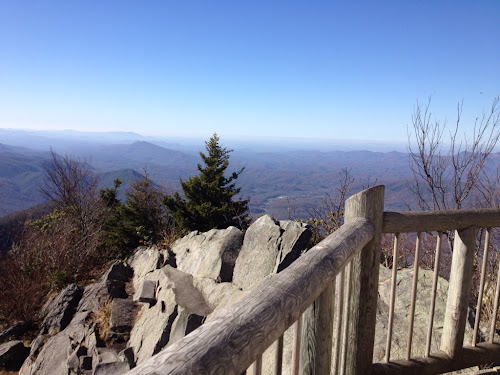 |
| Mt. Cammerer Lookout |
Snow was now edging the trail along both sides, left over from the superstorm. When we made the turn off of the AT to the little spur that goes to the Lookout, the snow was probably still 6-8 inches deep primarily because it was still so shaded. No matter the reason, the snow did lend a special beauty to this hike. We passed the tie-outs where four horses were resting having carried their owners up this mountain. They were beautiful and I experienced some mixed emotions. I felt sorry for them having to carry people up here, but I also was a bit wistful that their riders had definitely had an easier time of it that we had.
Finally, we made our way to a break in the cover and saw the Mt. Cammerer Lookout in front of us. It really is a beautiful structure which seems like it rises out of the granite rock upheavals all on its own. In reality, it was hand hewn from rocks nearby and constructed by workers of the CCC during the days of the New Deal. Regardless of how it got there, it is a Great Smoky Mountains National Park treasure! The Lookout offers 360 degree views and a marvelous place to rest and recover--one of the most beautiful picnic spots I've ever seen.
While we were there, enjoying the vistas, a familiar black suited creature came literally out of nowhere. He did not come up the trail; instead, he just appeared from behind a rock or tree. Come to find out, this man hikes all over the Smokies--OFF trail! He has been to Mt. LeConte 32 times and never on trail. He had been climbing up the ravine when he met us, turned the opposite way from us on Lower Mt. Cammerer, and had ascended to the top via other such ravines and rock outcroppings. I guess you could call him an extreme hiker. He turned out to be very nice--as are most humans who have hiking as a hobby it seems--and also very knowledgeable. I asked him if he knew what he was looking at as we all took in these incredible views. He pointed out each of the mountaintops and called them by name--Mt. Sterling, Mt. Guyot, and many more. He told us that if we climbed up on top of the railing of the Lookout, you could see some incredible outcroppings of rock. We told him that we would pass on the climbing up on the railing part! We would also leave the off-trail hiking to him. We do well to do the hiking ON-trail!

Sadly, time was passing quickly and the sun was visibly lower in the sky than I really wanted it to be. We left the Lookout and reached the intersection with the AT again at 3:00 p.m. That left us with just 2.5 hours to make it back to the base of this mountain. We still had approximately 5.9 miles to go and we knew full well that going down is sometimes harder than going up. It has its own treacheries.
Needless to say, the descent down first the AT and then Lower Gap is a blur of leaf-strewn trail, rocky footpaths, and evil tree roots whose sole purpose in life is to trip up a hiker. It is a beautiful path, but I'm glad we were going down and not up. The loose rocks and steep slope of the Low Gap trail would have made for a difficult ascent, although it would have been much shorter than the way we had come. What I remember most about that trail was the feel of my toenails being ripped off by the continual bumping into the end of my sock and toe box of my boot and knowing that stopping to re-lace my boots might help. However, I was not going to be the one who was responsible for us getting caught hiking in the dark, so I just trudged on.
We did make it out while daylight was still with us. We hit the trailhead at 5:30 p.m.--one minute before the official setting of the sun. It was quite dusky, however, we did notice that, as we had hoped in case we were later than this, there is enough daylight left after sunset, even in the mountains to still see for probably another 30 minutes, easy. We had brought flashlights with us (well, two of us had), but none of us wanted to be on the trail in the dark with just a flashlight. Luckily, we didn't need them.





